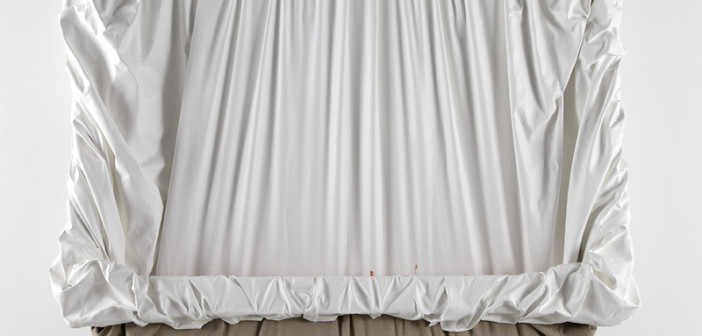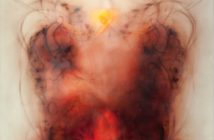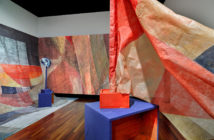In historicizing the minimalist canvas, critics have pointed to some form of the merger between the subject of a painting and the object used to support it—for a few this "maddening" notion was the "subjectile," that physical part of art which allows for presentation (a frame, a canvas, a support). This merger of the subject and the object provided much of the pretext for late modernism’s approach to painting, engrossed as it was in the power of the subjectile over the painted image.
In Gag, a series of new works by Analia Saban at Tanya Bonakdar Gallery, the artist plays on different notions of the orthodoxy of the minimalist canvas, especially those located around the idea of the materiality of the support becoming the very subject of the work. Jean Clay has engaged the work of nearly the whole of modernist painting through this rubric, and cites its culmination in the canvases of Robert Ryman. Despite Saban’s Rymanesque formal maneuvers, the triumph of the subjectile over the subject—as Clay terms it—is not what Gag is explicitly interested in. Instead the work can be thought of as various instances of the now victorious subjectile playfully asking the subject to come back. The response, seen through the symbol of paint, burns, industrial objects, and rendering of architectural space is that such a return is not so easy, just not as clean as we had imagined it might be. The result is a gag played on the presuppositions of the history of late modernism.
Saban first establishes the point from which the subject must return. The Slab Foundation works consist of poured concrete over canvas, hung traditionally on the gallery wall. In lieu of paint, it is the concrete—a means of support in the west dating back to the Roman Empire—which is the material used to mark the canvas, providing the most direct and absurd exercise of the subjectile (the support) reigning as subject.
Another group of works engage the form of the subjectile, though they are more directly concerned with concealing the act of painting. California King Fitted Bed sheet with Broken Elastic (2012), Wall Corner (with pinhole), Cast in Paint (2012), and Two Stripe Bath Towel (2012) are common objects situated as white painted, canvas surrogates, both draped upon a background support canvas structure. These hung objects also provide a blank picture plane themselves. Literal notions of support (as construction) are invoked—Wall Corner is partly comprised of extending wood pieces (which may be referencing a wall and the back of a canvas) in yet more ambiguous theatricality of the subjectile.
Painting (with brush) (2012) is a large rectangular canvas adorned with haphazard white paint marks; the mark-making tool—a toilet brush—hangs auspiciously at the base of the canvas. The process of painting is at first hidden, until Saban conjures it back, casting it in an ardent joke on the very materiality of paint.
The predominant statement of the show arrives as Saban negotiates an opposition amongst the works above. There are those that are steadfast in concealing or trivializing the process of painting, and those works which, using the very same currency of the triumph of the subjectile over the subject, do not conceal as much as they trouble the notion of painting by heavily dramatizing its tactile realities. In Trough (fear) (2012), the viewer approaches a canvas folding in on itself, weighed down by 110 pounds of oil paint. The paint’s precarious relationship with the supporting canvas not only draws attention to Saban’s theory of painting as merely a "container of paint," but also carries through Ryman’s act of subjecting the work the effects of time. For Ryman, this meant the rusting of his metal. Here Saban engineers such a situation by calling attention to the effect that time (and gravity) will have on the support, which is to threaten it. The paint, removed from its role as a marking agent upon the canvas, is now a theatrical agent, and literal burden on the security of the white canvas. Paint reverses and negates the utility of the canvas, rendering it disabled. Rather than enhancing it, paint is a means of undoing the artifice of its component parts.
Saban’s work prior to Gag suggests that while she is formally and intellectually versed in the warmed over precepts of 60s minimalist painting and post-painterly discourse, she is happy to venture in with an keen sense of irony, further displaying her ability to draw on art historical referents in earnest and in detachment. In creating several defective means of support, through burning, concrete surrogates, weight burdens, and ambiguous figure/background relationships, Saban extends the very same suspicion that was previously directed at paint to expose the orthodoxy of the subjectile. According to one theoretical tradition, post-painterly and minimalist abstraction emerged from the merger of the subject and the subjectile. After Ryman, we know first-hand the vulnerability of painting—we have seen the full extent of, as Clay writes, the "distortion through which the entire organism [of painting]might come undone." Saban provides a solution to this ersatz problem of aesthetics.




